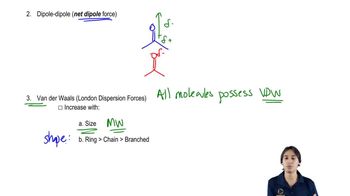Which of the preceding compounds forms hydrogen bonds with a solvent such as ethanol?
4. CH3CH2CH2NHCH3
5. CH3CH2CH2COOH
6. CH3CH2CH2CH2F

 Verified step by step guidance
Verified step by step guidance Verified video answer for a similar problem:
Verified video answer for a similar problem:



 3:08m
3:08mMaster How IMFs are related to melting and boiling points. with a bite sized video explanation from Johnny
Start learning